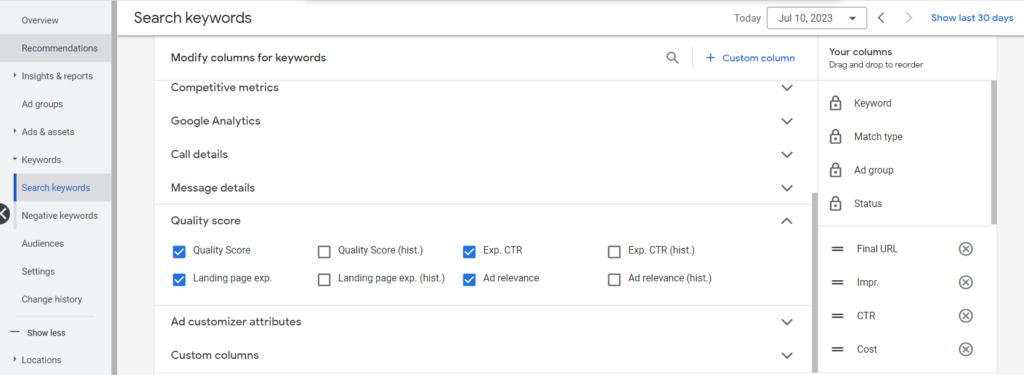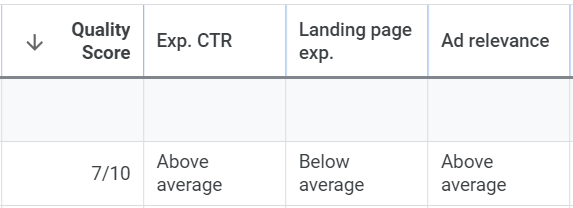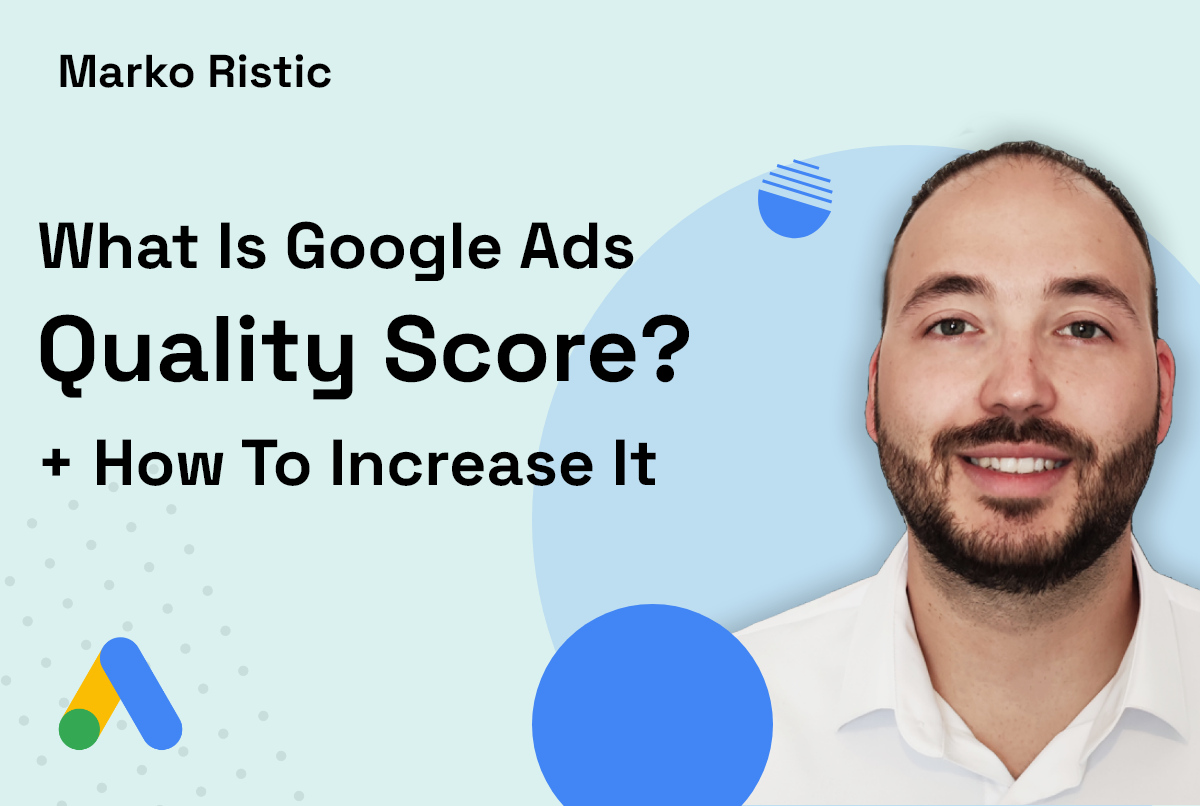I pay a lot of attention to the Google Ads Quality Score when I’m auditing accounts and optimizing campaigns. Why? Because it gives me insights into the user experience and helps me optimize the campaigns effectively.
In this blog post, I will first explain the Quality Score and why Google advertisers should care about it. Then, I will provide ways on how to improve it and how I do it.
Let’s kick off by explaining what it is.
What is Google Ads Quality Score?
Google Ads Quality Score is a measure of how relevant and useful your ads and landing pages are to people who are searching for your keywords. It is a number on a scale of 1 to 10, with 10 being the highest. A higher Quality Score means that your ads are more likely to show at the top of the search results and that you will pay less per click.
Simply put:
A higher score means your ad, targeted keyword, and landing page are more relevant and useful to searchers compared to other advertisers.
Google monitors user experience and provides feedback through this score, so this is a valuable tool for improving your campaigns.
It’s crucial to understand that improving the Quality Score isn’t a one-time task, it’s an ongoing process. Make sure to consistently work on it and regularly review its progress.
Notes from Google on Quality Score:
– Quality Score is not a key performance indicator and should not be optimized or aggregated with the rest of your data.
– Quality Score is not an input in the ad auction. It’s a diagnostic tool to identify how ads that show for certain keywords affect the user experience.
How is the Quality Score calculated?
There are three main components:
– Expected Click-Through Rate (CTR)
– Ad Relevance
– Landing Page Experience
Expected Click-Through Rate (CTR)
Expected Click-Through Rate (CTR) is an estimate of how likely someone is to click on your ad when they see it.
Ad Relevance
Ad Relevance is a measure of how closely your ad matches the search intent of the person who is searching for your keyword.
Landing Page Experience
Landing Page Experience measures how well your landing page meets the expectations of the people who click on your ad.
Google evaluates each component of the Quality Score and assigns it a status: “Above average,” “Average,” or “Below average.” They determine these statuses by comparing your performance with other advertisers who had their ads displayed for the same keyword in the past 90 days.
Why should we spend time improving Google Ads Quality Score?
Quality Score is very important and not something that should be overlooked. Let’s cover how you benefit when you improve your Quality Score and how can this positively impact the performance of the campaigns:
Improved ad rankings and visibility
A higher Quality Score increases the likelihood of your ads appearing at the top of the search results. When your ads have better visibility, they are more likely to be seen by potential customers, leading to increased click-through rates and better overall campaign performance.
Another benefit – when you are working on increasing the Ad visibility, you can also outrank competitors’ Ads and appear above them, so this can give you a competitive edge over them. More relevant clicks can lead to more potential customers.
Lower cost per click (CPC)
With a higher Quality Score, you are likely to pay less for each click. Paying less for each click means more clicks for the same budget and more potential customers. Google “rewards” advertisers who provide relevant and high-quality ads by offering them lower CPCs. So you are using the budget more wisely and that can lead to having a better return on investment (ROI).
Better performance
By focusing on improving your Quality Score, you naturally improve the relevance and quality of your ads. When you have keywords that match with relevant Ads and landing pages, users have better experience and this can lead to better campaign performance.
How can you see the Quality Score?
– In your Google Ads account, click on Campaigns.
– Click the Keywords in the section menu then click Search Keywords.
– Then click columns to add new things to your table.
– Open the Quality Score section and add Quality Score, Landing Page Exp., Exp. CTR and Ad Relevance.

How can you improve your Google Ads Quality Score?
There are a number of things you can do to improve your Google Ads Quality Score. You can use relevant keywords, write relevant Ad copy, target long-tail keywords and create better landing pages. Let’s break down each of these points:
Use relevant keywords
When you are creating your ad groups, make sure you use keywords that are closely related to the service/product and landing page.
Let’s see an example:
Product: Time Management Software, SaaS Industry
Let’s imagine you offer Time Management Software aimed at helping professionals boost productivity and manage their tasks efficiently.
In your Google Ads campaign, you create an ad group with keywords such as “time management software”, “time management system” and “time management platform”. These keywords are closely aligned with your SaaS product, Ad copy has these keywords and the landing page is also relevant – everything is relevant to individuals or businesses seeking efficient time management solutions.
By using these relevant keywords, you increase the likelihood of your ads appearing to users who are actively searching for time management software, leading to higher click-through rates and a better Quality Score.
Now, if we add the keywords such as “productivity tools” and “work schedule optimization” to this same Ad group, these keywords might get a lower Quality Score. Why? Even though they are related to the SaaS product, the Ad copy might not be 100% relevant to these keywords and also to the landing page (the landing page might not have these keywords on it).
So the best practice here is to move these keywords to a new Ad group, write new Ad copies that are relevant and possibly create a new landing page that has these keywords on it. This will potentially increase Quality Score on these keywords.
Write clear and concise ad copy
Your ad copy should be clear and concise, and it should be super relevant to the keywords you are targeting (target audience’s search intent). You should also use keywords in your ad copy but don’t overdo it.
Let’s see an example:
I will again use Time Management Software, SaaS Industry as an example.
Your copy should resonate with the target audience’s search intent. Let’s assume you are targeting the keyword “time management software.” A good implementation of clear and concise ad copy would be:
Headlines: Time Management Software | Optimize Your Work Schedule | Brand Name
Description: Maximize productivity with our time management software solution. Book a demo today.
In this example, the ad copy is clear and highlights the software’s ability to boost productivity and optimize work schedules. The messaging is concise, conveying the value proposition within the character limit while using the relevant keywords naturally.
Now, let’s cover, in my opinion, a bad example:
Headlines: Discover this Amazing Solution | Cutting-Edge Productivity | Time Management Tool
Description: Manage tasks effortlessly, save time, and boost efficiency. Book a demo today.
In this example, the ad copy lacks clarity. It contains excessive jargon, doesn’t have our target keyword and is difficult for reading.
Therefore, make sure your Ads are delivering a concise message that highlights the key features, value proposition, benefits of your software and are relevant to the intent of users searching for time management software keywords.
Target long-tail keywords
Long-tail keywords are more specific than short-tail keywords. They have fewer impressions but they tend to have lower competition. This means that you are more likely to get a higher Quality Score and a lower cost per click if you target long-tail keywords with relevant Ad copies and relevant landing pages. Also, long-tail keywords are showing more intent than short-tail keywords so they usually perform better.
Example:
Short-tail: productivity tools
Long-tail: Office productivity tools
Create high-quality landing pages
By high-quality, I mean landing pages that give users enough information so that they can make an informed decision and take action (Book a demo, register for a webinar, etc.).
The landing page should be super relevant to your targeted keywords and ads, and they should provide a positive user experience (load times are fast, the page is mobile friendly, etc.). All these things will impact the Quality Score so you need to work on optimizing them.
Here are just a few things that all landing pages should have when they are used for Google Ads:
Focused Keyword
Landing pages should have a focused keyword that you are targeting with Google Search Ads. You also need to have consistent messaging from the ad to the landing page to have a good user experience. Users tend to convert more when they have a good user experience and when they get the information they came for (the info that was promised in the Ad).
Right information
The information on the landing page should match exactly with the user’s intent. The product’s benefits should be communicated clearly so that the user can immediately understand how the product will solve the current problem that the user is having.
Strong call-to-action (CTA)
This is something that all products are having but not all products are doing it right. CTA should be specific and visible on the landing page, guiding users to take the desired action such as booking a demo, registering for a webinar, etc. Avoid having different CTAs on the landing page. Users are more likely to convert if there is only one CTA showing that that is the next step.
Fast loading speed
Optimize your landing page to load quickly. Users have a limited attention span, and a slow-loading page can lead to higher bounce rates and lower conversion rates. I’m not going to cover things that can be optimized here because they are too technical but keep in mind that Google is taking the loading time seriously.
Mobile-friendly landing page
The vast majority of internet users are browsing on mobile devices, so it’s crucial to have a mobile-friendly landing page. Ensure that your page is responsive and adapts to different screen sizes to provide a good experience for mobile users.
Minimal distractions
Remove any elements that could redirect the user’s attention away from the main call to action. Keep the landing page focused and free from distractions.
Trust and credibility elements
Testimonials, customer reviews, security badges and certifications are great ways for establishing credibility and trust. Make them real and visible on the landing page. Showcase people’s experiences while using the product.
How can you use Exp. CTR, Landing Page Exp. and Ad Relevant metrics?
Example No.1:
If your expected CTR is Above Average, your Landing Page experience is also Above Average but your Ad Relevant is Below Average, you should work on your Ad copies so they can be relevant to the keyword you are targeting and with the landing page people are going after clicking on your Ad.
Example No.2:
If your expected CTR is Above Average, your Landing Page experience is Below Average and your Ad Relevant is Above Average, you should work on your landing page. Google is giving you feedback that the user experience is not that great on the landing page so you will need to work on optimizing it.

What is a good Quality Score to have?
In my opinion, the good Quality Score to have is everything above 7/10. If you have keywords with Quality Scores below this you should first focus your energy and time on them.
Conclusion
Improving the Quality Score is not about achieving short-term benefits. By working on all things I mentioned above, Ad relevance will increase, your CTR will increase, your landing page will be more user-friendly offering proper information to the users and these improvements will make campaigns perform better. So it’s a full cycle.
Remember, it’s an ongoing process, so stay proactive and determined to optimize it properly for long-term success.
I hope this was beneficial! If you have any questions or comments about Google Ads Quality Score, feel free to write a comment below or get in touch with me on social (LinkedIn, Twitter) or via email (contact@markoristic.digital).
Stay sharp and till the next time, bye!


